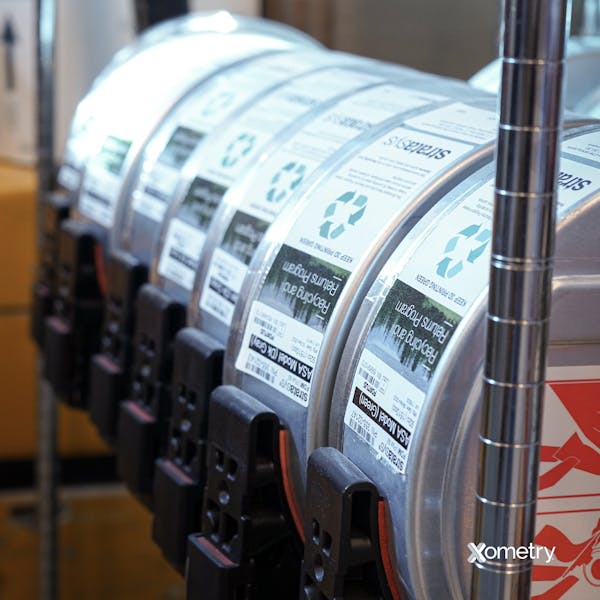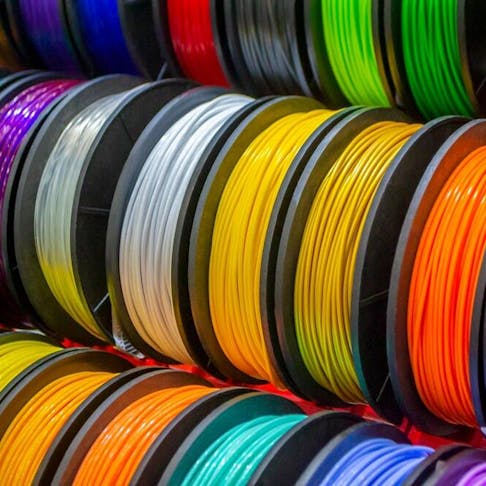FDM (or fused deposition modeling) 3D printers use filaments to create the objects they print. These filaments are available in a variety of materials and they come on spools. The material from the spool is fed through the printer’s extruder and out of the heated nozzle to create the 3D product, layer by layer.
The type of filament you need depends on the type of object you want to print. We break down each of the different 3D printer filaments available, listing their properties and pros and cons, to help you decide which one is best for your particular project.
PLA Filament
First up is PLA, or polylactic acid. Unlike most other filaments that contain petroleum, PLA is made from organic materials. This thermoplastic monomer is user- and environmentally friendly, doesn’t easily warp during printing, and it’s food-safe, too. It’s not water-soluble, but it can be dissolved with acetone, methyl ethyl ketone, or caustic soda. PLA is, however, a bit more fragile than some other filaments, and doesn’t have a good UV resistance.
| Tensile Strength | Flexural Modulus | Print Temperature | Print Bed Temperature |
|---|---|---|---|
Tensile Strength 65 MPa | Flexural Modulus 3.8 GPa | Print Temperature 130 to 180 °C | Print Bed Temperature 50 °C |
Some types of PLA filament can be conductive.
ABS Filament
Acrylonitrile Butadiene Styrene, or ABS, is a popular engineering plastic and 3D printing filament type that’s tough and can hold its own in high temperatures—which is just as well because printing with ABS uses high temperatures for both the hot end and the printer bed.
It needs heated build volumes in order to get proper results since ABS can warp during printing, leading to inaccurate dimensions. At Xometry, we use industrial machines from the Fortus lineup by Stratasys in order to provide consistent results and open the door to serial production. ABS is known for its durability; it’s impact resistant and can survive wear and tear. Like PLA, it isn’t water soluble, but it can be dissolved with organic solvents like acetone, methyl ethyl ketone, and esters. It’s also food safe.
| Tensile Strength | Flexural Modulus | Print Temperature | Print Bed Temperature |
|---|---|---|---|
Tensile Strength 40 MPa | Flexural Modulus 1.6 to 2.4 GPa | Print Temperature 220 to 250°C | Print Bed Temperature 95 to 110°C |
For more information, see our full guide on ABS 3D Printer Filament.
Carbon Fiber Filament
Filaments filled with carbon fiber are made with enhancing additives to improve their mechanical properties or overall appearance. They have better dimensional stability than some other types of filament, and don’t warp as much. They can increase the durability of ABS, but are more brittle and likely to clog. Carbon fiber filament can be dissolved with organic solvents.
| Tensile Strength | Flexural Modulus | Print Temperature | Print Bed Temperature |
|---|---|---|---|
Tensile Strength 46 MPa | Flexural Modulus 5.26 GPa | Print Temperature 220 to 240°C | Print Bed Temperature 100 to 110°C |
Nylon Filament
Nylon (aka polyamide) is a popular engineering plastic thanks to its excellent durability and wear resistance. The most commonly used grade of nylon for hobbyists is PA 6. Nylon is both impact and wear-resistant. That said, nylon absorbs moisture easily, and it requires print temperatures as high as 265℃. There are even food-safe grades of nylon. Due to the high heat, Nylon tends to warp during printing but this can be somewhat contained with a heated enclosure. Nylon expands in water as it’s a hygroscopic material, and it can be dissolved in acetic and formic acids.
While nylon can be a desirable material to print in due to it’s overall excellent characteristics, it can be more challenging to work with. At Xometry, we can handle the hassles thanks to our industrial platforms, allowing us to reliably print Nylon 12 parts with our FDM, MJF, and SLS printing processes.
| Tensile Strength | Flexural Modulus | Print Temperature | Print Bed Temperature |
|---|---|---|---|
Tensile Strength 40 to 85 MPa | Flexural Modulus 0.8 to 2 GPa | Print Temperature 225 to 265°C | Print Bed Temperature 70 to 90°C |
FLEX Filament
FLEX filament is a proprietary blend of polymers that creates a flexible copolymer 3D printing filament type. It’s part of the thermoplastic polyurethane, or TPU, family of materials. Parts printed with this material can attain a shore A hardness of 93 A. The parts are also flexible and impact resistant, as well as hygroscopic. This means they should be dried before use, and kept dry during long prints. This filament is durable by nature, as are most flexible materials, and it won’t warp, either.
| Tensile Strength | 100% Modulus | Hardness | Elongation at Break | Print Temperature | Print Bed Temperature |
|---|---|---|---|---|---|
Tensile Strength 40 MPa | 100% Modulus 9.5 MPa | Hardness 93 Shore A | Elongation at Break 500% | Print Temperature 210 to 230°C | Print Bed Temperature 60°C |
HIPS Filament
HIPS, or high impact polystyrene, is a thermoplastic often used for pre-production machining prototypes. Since ABS and HIPS have similar properties, HIPS is often used as a support material for ABS. It’s durable, flexible, strong, food safe, and soluble in D-limonene. On the down side, HIPS releases dangerous fumes during printing so a well-ventilated printing area is necessary. You can also use a duct to lead the fumes outside. In addition, HIPS will warp if the temperature isn’t very carefully controlled. Using heated enclosures with HIPS filament is the best way to go.
| Tensile Strength | Flexural Modulus | Print Temperature | Print Bed Temperature |
|---|---|---|---|
Tensile Strength 32 MPa | Flexural Modulus 1.5 to 3 GPa | Print Temperature 230 to 245°C | Print Bed Temperature 100 to 115°C |
PVA Filament
This plastic filament is biodegradable, user-friendly, and won’t warp as much as some other filament types. PVA, or polyvinyl alcohol, is frequently used as a support material for PLA, and it dissolves easily in just water. This does, however, mean that any moisture can damage it rendering it fairly useless in most functional applications, and it’s not recommended for food. It’s also a more expensive filament.
| Tensile Strength | Flexural Modulus | Print Temperature | Print Bed Temperature |
|---|---|---|---|
Tensile Strength 78 MPa | Flexural Modulus - | Print Temperature 185 to 200°C | Print Bed Temperature 45 to 60°C |
PETG Filament
Polyethylene terephthalate glycol-modified, or PETG, is a modified variant of PET. It uses glycol to bring down the melting temperature, making PETG more user-friendly. It’s UV-resistant, however it also bonds poorly, and creates strings across empty spaces when printing. PETG is highly durable, doesn’t really warp, and is food safe, just like PET. PETG is soluble in toluene and methyl ethyl ketone.
| Tensile Strength | Flexural Modulus | Print Temperature | Print Bed Temperature |
|---|---|---|---|
Tensile Strength 53 MPa | Flexural Modulus 2.2 GPa | Print Temperature 230 to 250°C | Print Bed Temperature 75 to 90°C |
For more information see our full guide on PETG 3D Printer Filament.
TPE Filament
Thermoplastic elastomers are flexible materials that can be melt-processed in most types of 3D printers. Although it’s commonly mistaken for TPU, TPE has a softer score. TPE has good abrasion resistance and excellent flexibility, doesn’t warp, has high elasticity, and bonds well. The below table lists the mechanical properties of TPE, based on the FilaFlex TPE filament.
| Tensile Strength | 100% Modulus | Hardness | Elongation at Break |
|---|---|---|---|
Tensile Strength 32 MPa | 100% Modulus 3.6 MPa | Hardness 70 A | Elongation at Break 900% |
PC Filament
Known for being one of the strongest and most durable 3D printer filament types, polycarbonate (PC) is an advanced engineering thermoplastic with impressive mechanical properties. The high strength, as well as a glass transition temperature of 150℃, makes it a perfect choice for high-temperature applications. Polycarbonate filament needs to be printed at temperatures of up to 310℃. It’s food-safe, and dissolves in tetrachloromethane, pyridine, and chloroform. It’s also highly likely to warp, and hygroscopic, meaning it will easily absorb moisture, which can cause defects in printed parts.
Polycarbonate is available at Xometry in both a standard and a biocompatible variant known as PC-ISO, which can be suitable for certain medical applications.
| Tensile Strength | Flexural Modulus | Print Temperature | Print Bed Temperature |
|---|---|---|---|
Tensile Strength 72 MPa | Flexural Modulus 2.2 to 2.5 GPa | Print Temperature 260 to 310°C | Print Bed Temperature 80 to 120°C |

How to Choose the Best Type of Filament
Different 3D printer filaments are better suited for different tasks, so the one you choose will depend on what you have to make. For quick prototypes, PLA can be fine. For an object that needs to be strong and durable, you might want to go for ABS. In general, 3D printing is a lot easier with a material that doesn’t warp or absorb moisture.
| Property | PLA | ABS |
|---|---|---|
Property Tensile Strength | PLA 65 MPa | ABS 40 MPa |
Property Stiffness | PLA 3.8 GPa | ABS 1.6 to 2.4 |
Property Glass Transition Temperature | PLA 50 to 80°C | ABS 105°C |
Property Ease of Printing | PLA Essentially plug-and-play | ABS Requires high temperatures, tends to warp, and requires a heated build volume |
Property Chemical Resistance | PLA Good chemical resistance | ABS Good chemical resistance |
Property Durability | PLA PLA is brittle and cracks easily. It cannot withstand long-term outdoor exposure | ABS ABS is very durable, with high impact resistance and good wear resistance |
Summary
In this article, we reviewed the mechanical properties, characteristics, advantages and disadvantages of the 10 most common 3D printer filaments. To learn more about 3D printer filament types and uses, as well as how Xometry can assist with 3D printed parts, contact a Xometry representative.
Here at Xometry, we offer full range of custom 3D printing services for your project needs. Visit our Instant Quote Engine to get an instant quote in seconds.
Disclaimer
The content appearing on this webpage is for informational purposes only. Xometry makes no representation or warranty of any kind, be it expressed or implied, as to the accuracy, completeness, or validity of the information. Any performance parameters, geometric tolerances, specific design features, quality and types of materials, or processes should not be inferred to represent what will be delivered by third-party suppliers or manufacturers through Xometry’s network. Buyers seeking quotes for parts are responsible for defining the specific requirements for those parts. Please refer to our terms and conditions for more information.


